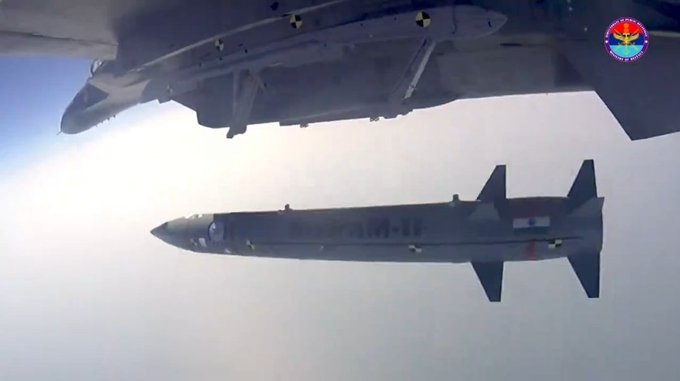SOURCE: AFI


The evolving maritime security landscape in the Indian Ocean Region (IOR) demands that the Indian Navy maintain a decisive edge over potential adversaries, including the Pakistan Navy. With the Pakistan Navy modernizing its fleet and acquiring advanced submarines and surface combatants, India must leverage its technological and strategic advantages to ensure maritime dominance. One potent option is arming the Indian Navy’s Boeing P-8I Neptune maritime patrol aircraft with the Rudram-II anti-ship missile variant, a move that could significantly enhance its offensive capabilities and deterrence posture.
The Pakistan Navy, though smaller than its Indian counterpart, has been steadily enhancing its capabilities. With Chinese assistance, it has inducted advanced platforms like the Type 054A/P frigates and Yuan-class submarines equipped with anti-ship cruise missiles (ASCMs) and torpedoes. These assets, combined with Pakistan’s focus on sea denial strategies, pose a credible threat to Indian naval operations, particularly in the Arabian Sea. The Pakistan Navy’s ability to deploy submarines and surface combatants in choke points like the Gulf of Oman or near the Makran coast underscores the need for India to maintain long-range, precision strike capabilities.
The Indian Navy’s P-8I Neptune, a variant of the U.S. Navy’s P-8A Poseidon, is a multi-mission maritime patrol aircraft designed for anti-submarine warfare (ASW), anti-surface warfare (ASuW), and intelligence, surveillance, and reconnaissance (ISR). Equipped with advanced sensors, sonobuoys, and Harpoon Block II missiles, the P-8I is already a formidable platform. However, integrating the indigenously developed Rudram-II anti-ship missile variant could further amplify its lethality, aligning with India’s push for self-reliance in defense manufacturing under the Atmanirbhar Bharat initiative.
The Rudram-II, developed by India’s Defence Research and Development Organisation (DRDO), is a next-generation air-to-surface missile designed for multiple roles, including anti-radiation and potentially anti-ship missions. While the missile is primarily tailored to suppress enemy air defenses (SEAD), its modular design allows for adaptations, such as an anti-ship variant. The Rudram-II boasts a range of approximately 300 km, a high-supersonic speed (Mach 2+), and precision guidance through inertial navigation, satellite-based GPS, and an active radar seeker. These attributes make it an ideal candidate for maritime strike roles.
Arming the P-8I with a Rudram-II anti-ship variant offers several strategic and operational advantages:
- Extended Stand-Off Range: The Rudram-II’s 300 km range surpasses the 124 km range of the Harpoon Block II, enabling the P-8I to engage enemy vessels from safer distances, beyond the reach of most Pakistani anti-aircraft systems like the HQ-16 on Type 054A/P frigates. This stand-off capability reduces the risk to the aircraft while maximizing its impact.
- Enhanced Lethality Against Modern Warships: The Rudram-II’s high-supersonic speed and active radar seeker make it difficult for enemy ships to evade or counter. Its warhead, which can be tailored for anti-ship roles, could effectively target Pakistan’s frigates, corvettes, and even submarines if surfaced or detected at periscope depth.
- Synergy with P-8I’s Sensor Suite: The P-8I’s advanced radar (AN/APY-10), electro-optical/infrared systems, and data-linking capabilities allow it to detect, track, and engage targets at long ranges. Integrating Rudram-II would leverage these sensors to deliver precise, over-the-horizon strikes, enhancing the aircraft’s ASuW role.
- Indigenous Advantage: Unlike the Harpoon, which is imported from the U.S., the Rudram-II is an indigenous system. Arming the P-8I with Rudram-II aligns with India’s goal of reducing dependence on foreign suppliers, lowering costs, and fostering domestic defense innovation. It also ensures greater flexibility in missile upgrades and maintenance.
- Deterrence and Regional Power Projection: Deploying Rudram-II-armed P-8Is would send a strong message to Pakistan and other regional players, reinforcing India’s ability to dominate the IOR. The combination of long-range ISR and precision strike capabilities would deter hostile naval movements and secure India’s maritime interests, including critical sea lines of communication (SLOCs).
NOTE: AFI is a proud outsourced content creator partner of IDRW.ORG. All content created by AFI is the sole property of AFI and is protected by copyright. AFI takes copyright infringement seriously and will pursue all legal options available to protect its content.